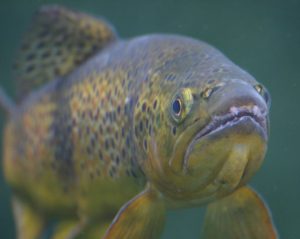Wild Pacific Salmon is a species essential for equilibrium and the economic, cultural, and ecological balance in British Columbia.
Quick Facts on Salomon Populations and Conservation Measures
Wild Pacific Salmon belongs to the group of Oncorhynchus and is found in the Pacific Ocean. Fishing quotas are largely determined by the abundance, availability, and health of wild populations and not by the availability of farmed fish. This means that fishermen are allowed to fish up to a certain amount and are not legally permitted to exceed the quota. The problem is that farmed fish has already flooded the market, lowering the price of wild salmon. This has resulted in significant income losses in coastal areas, and the question of whether fishermen fish up to the amount permitted has reemerged. What is more, farmed salmon has become a threat to wild populations because net-cages are the breeding ground for various diseases and parasites that contaminate the water of wild populations. Another problem is that farmed fish often escapes the nets and transfers parasites to wild populations. They also compete for food with wild fish.
How to Protect Wild Salmon
There are many steps to ensure that wild salmon populations thrive in a healthy and safe environment. Many advocacy groups and non-for-profits work to protect wild populations, including Save our Wild Salmon, Trout Unlimited, the Pacific Rivers Council, and others. The first step may be to contact an advocacy group and report a violation or ask about the different ways you can help (e.g. donation, volunteering, etc.) Choosing wild salmon to farmed salmon is also a good way to show support.
It is also important to protect the habitat of wild salmon to ensure healthy populations. To this, a key step is to establish safeguards and protect water bodies in which wild salmon thrives and to prevent new threats. One idea is to create protected areas or strongholds and mimic the conditions that allow wild salmon to best adapt and thrive. This is one option in the face of environmental and other issues such as increasing pressure from hatchery fish, resource extraction and depletion, climate change, and so on. The focus will be on long-term measures and protection. There are organizations that have successfully established protected areas in different regions across the world, for example, Tugursky Nature Reserve, Shantar Islands National Park, Koppi River Nature Reserve, Vostochnii Wildlife Refuge, and others. Some of these areas are specifically established and designated to promote and preserve aquatic diversity. Sanctuaries for Wild Pacific Salmon can be created in British Columbia in cooperation with state agencies, local partners, and other interested parties. It is also a good idea to create state conservation areas for wild salmon populations to protect natural resources and forests that benefit wild fish, including forest products, carbon sequestration, clean water, and so on. This will definitely aid wild salmon recovery. There are other essential steps to this end, and one is to review national legislation and identify areas for improvement. The U.S., for example, has introduced a new piece of legislation, the Pacific Salmon Stronghold Conservation Act to aid the recovery of wild salmon populations that are federally listed. The act will establish a grant program to aid recovery and conservation.
Speak Your Mind
You must be logged in to post a comment.